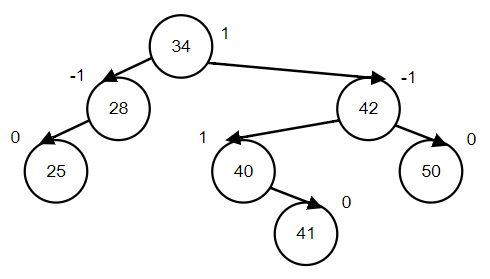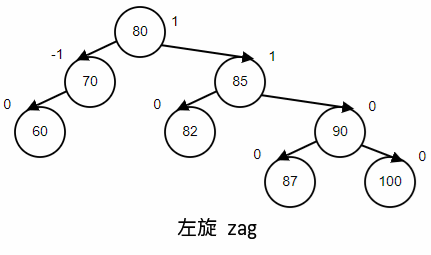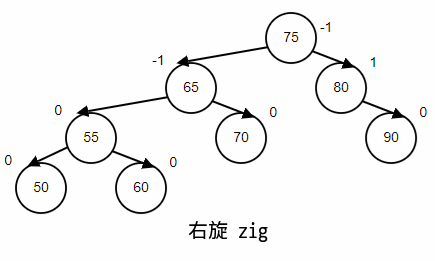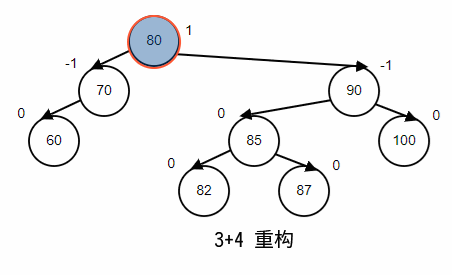本文将主要讲解平衡二叉树中的 AVL 树,其中将重点讲解二叉树的重平衡方法,即左旋和右旋,以及 3+4 重构;这些方法都是后面要讲的 B 树,红黑树等 BBST 的重要基础;此外在看本文之前最好先看一下 二叉搜索树 ;
一、结构概述
前一篇博客里面讲了,二叉树同时具有向量的静态查找和列表的动态插入、删除等优点;当然这是在理想的状态下,但是当出现一些极端情况的时候,比如二叉树的右子树或者左子树全部为空,此时二叉树将退化为一个列表;所以为了避免这种情况就要使二叉树的左右子树尽量平衡,当然最好的情况是左右子树完全平衡,那么此时二叉树的查找效率就相当于二分查找;但实际上要维护二叉树的完全平衡非常困难,所以一般情况下我们都是维护二叉树的适度平衡,于是就产生了变种众多的 BBST(balance binary search tree);
其中 AVL 树 就是其中一种,即 左右子树的高度差(平衡因子)< 2; 如图所示:

图中每个节点上方的数字就是平衡因子;
主体结构如下:
public class AVLTree2<T extends Comparable<? super T>> extends BST<T> {
private AVLNode root;
private class AVLNode extends BST.Node {
private final T key;
private int height;
private AVLNode left;
private AVLNode right;
private AVLNode parent;
}
}
二、重平衡
在我们使用 AVL 树 的时候,必然会有动态的插入和删除,同时平衡也会被打破,此时我们就需要一些旋转操作使得 AVL 树能够再次平衡;
1. 单旋
左旋(zag)

情景重现,顺序插入,70,80,85,60,82,90,87,100;最后删除60
实现:
private AVLNode rotateLeft(AVLNode x) {
AVLNode y = x.right;
y.parent = x.parent;
x.right = y.left;
if (x.right != null) {
x.right.parent = x;
}
y.left = x;
x.parent = y;
if (y.parent != null) {
if (x == x.parent.left) {
y.parent.left = y;
} else {
y.parent.right = y;
}
} else {
root = y;
}
updateHeight(x);
updateHeight(y);
return y;
}
右旋(zig)

情景重现,顺序插入,65,75,80,90,70,55,60,50;最后删除90
实现:
private AVLNode rotateRight(AVLNode x) {
AVLNode y = x.left;
y.parent = x.parent;
x.left = y.right;
if (x.left != null) {
x.left.parent = x;
}
y.right = x;
x.parent = y;
if (y.parent != null) {
if (x == x.parent.left) {
y.parent.left = y;
} else {
y.parent.right = y;
}
} else {
root = y;
}
updateHeight(x);
updateHeight(y);
return y;
}
2. 双旋
对于以上左倾或者右倾的,自需要经过一次 zig 或者 zag 就可以恢复平衡;但是对于左倾右倾交叉的,则需要两次旋转;如图所示

对于以上情景的复现:
- 左图:顺序插入,70,80,90,60,100,85,82,87;最后删除60
- 中图:同上面左旋
3. (3+4)重构
当 AVL 树不在平衡的时候,任然还是一个 BST;也就是说不平衡的时候仍然有序,所以我们可以根据他的有序性直接构造出最终结果,而不是通过一次或者两次旋转;如图所示;

对于以上的各种重平衡方法,其 不变的都是树的顺序性,抓住这一点即使记不住旋转时候,节点之间关系的切换,画一个草图也能很快知道,应该如何调整;接下来我们就将使用上述的重平衡方法,继续研究 AVL 树使用过程中插入和删除的重平衡;
实现:
private AVLNode connect34(AVLNode a, AVLNode b, AVLNode c, AVLNode t0, AVLNode t1, AVLNode t2, AVLNode t3) {
a.left = t0;
if (t0 != null) t0.parent = a;
a.right = t1;
if (t1 != null) t1.parent = a;
updateHeight(a);
c.left = t2;
if (t2 != null) t2.parent = c;
c.right = t3;
if (t3 != null) t3.parent = c;
updateHeight(c);
b.left = a;
a.parent = b;
b.right = c;
c.parent = b;
updateHeight(b);
return b;
}
三、插入
@Override
public AVLNode insert(T key) {
AVLNode node = (AVLNode) super.insert(key);
updateHeight(node);
// 插入节点,只需要调整一次,但是有可能是父亲节点或者祖父节点;
for (AVLNode x = node; x != null; x = x.parent) {
if (!isBalanced(x)) {
balance(x);
break;
}
}
return node;
}
private AVLNode balance(AVLNode x) {
if (balanceFactor(x) < -1) {
if (balanceFactor(x.right) > 0) {
x.right = rotateRight(x.right);
}
x = rotateLeft(x);
} else if (balanceFactor(x) > 1) {
if (balanceFactor(x.left) < 0) {
x.left = rotateLeft(x.left);
}
x = rotateRight(x);
}
return x;
}
private int balanceFactor(AVLNode x) {
return height(x.left) - height(x.right);
}
private boolean isBalanced(AVLNode x) {
int i = balanceFactor(x);
return i > -2 && i < 2;
}
具体插入算法就是找到为空的叶子节点,然后插入,详情可见 二叉搜索树 ;
四、删除
@Override
public AVLNode delete(T key) {
AVLNode node = (AVLNode) super.delete(key);
// 删除原本就矮的一边,使得重平衡后高度减一,不平衡向上传播
// 使得祖父也不平衡,所以需要一次检查所有父亲节点
for (AVLNode x = node; x != null; x = x.parent) {
if (!isBalanced(x)) {
balance(x);
}
updateHeight(x);
}
return node;
}
同样具体的删除算法也请参考 二叉搜索树 ;其思路就是:
- 先查找,如果该节点的其中一个或两个节点为空,直接令其后代代替;
- 如果不为空,则找到直接后继,然后交换位置,在删除;
五、重构
使用 3+4重构 的方式,重平衡;
private AVLNode balance34(AVLNode g) {
AVLNode p = tallerChild(g);
AVLNode v = tallerChild(p);
if (balanceFactor(g) < -1) {
if (balanceFactor(g.right) > 0) {
/*
* O
*
* O
* /
* O
*/
return connect34(v, g, p, v.left, v.right, g.left, p.right);
} else {
/*
* O
*
* O
*
* O
*/
return connect34(g, p, v, g.left, p.left, v.left, v.right);
}
} else if (balanceFactor(g) > 1) {
if (balanceFactor(g.left) < 0) {
/*
* O
* /
* O
*
* O
*/
return connect34(p, v, g, p.left, v.left, v.right, g.right);
} else {
/*
* O
* /
* O
* /
* O
*/
return connect34(v, p, g, v.left, v.right, p.right, g.right);
}
}
return g;
}
总结
- AVL 树同二叉搜索树相比无论查找,插入还是删除,其时间复杂度都只有
LOG(n); - 但是从上述的讲解也可以看到插入和删除都需要旋转操作,成本仍然比较高;